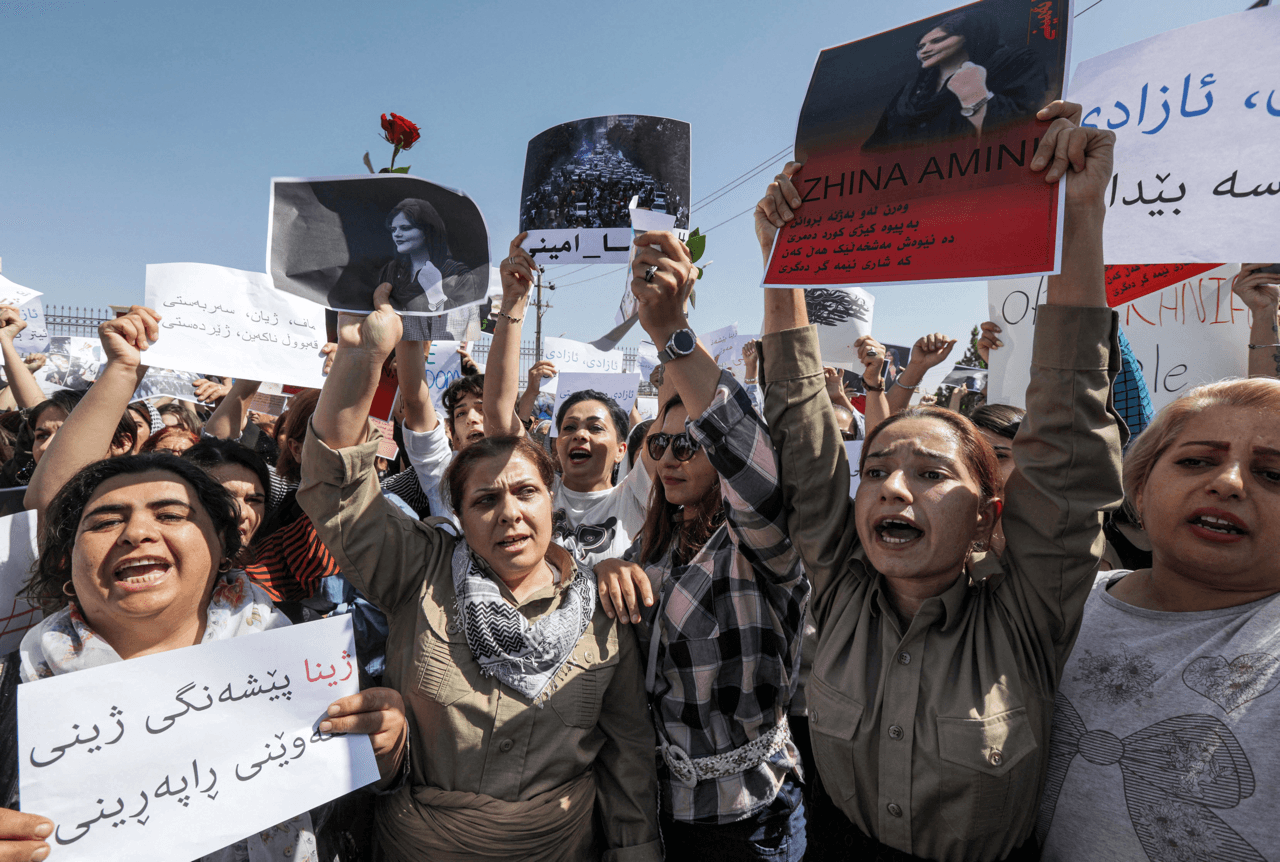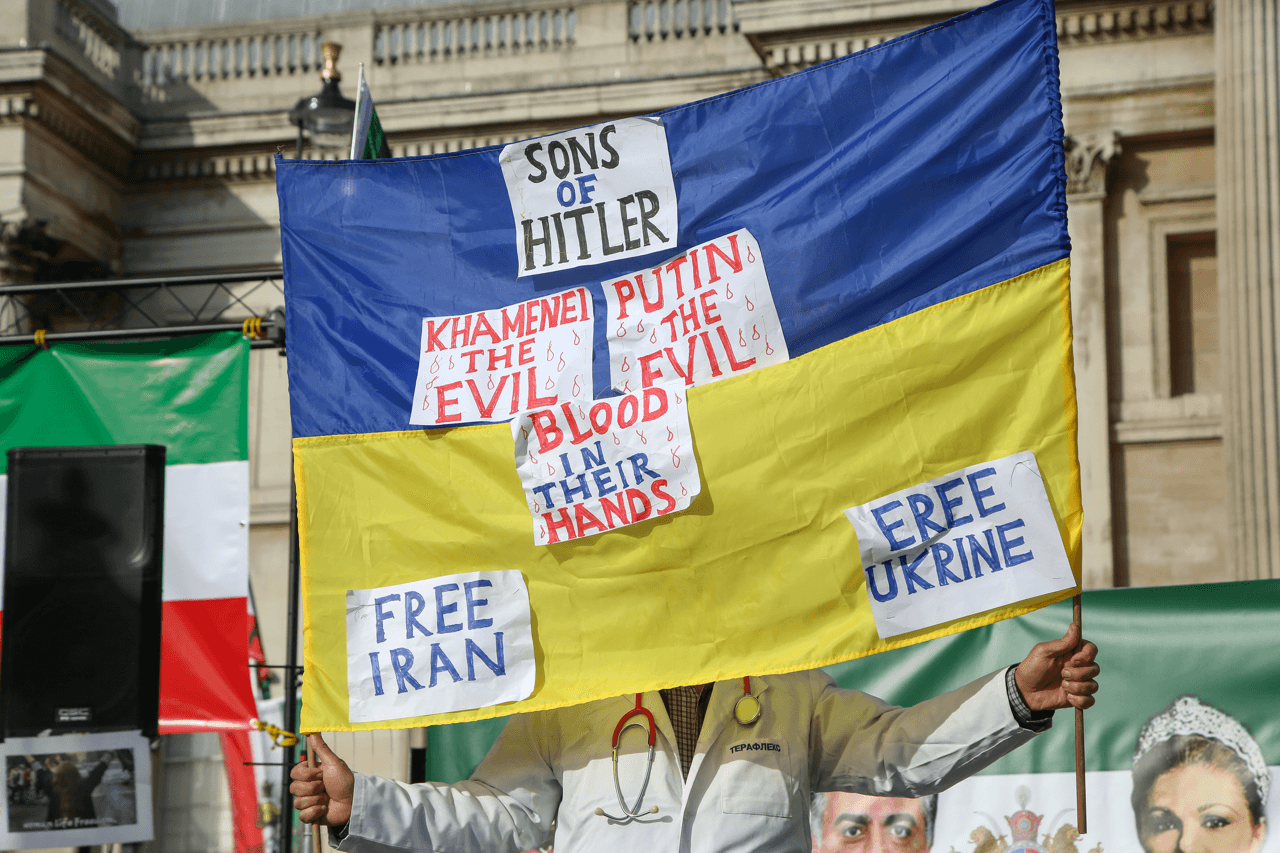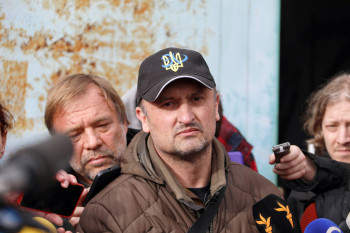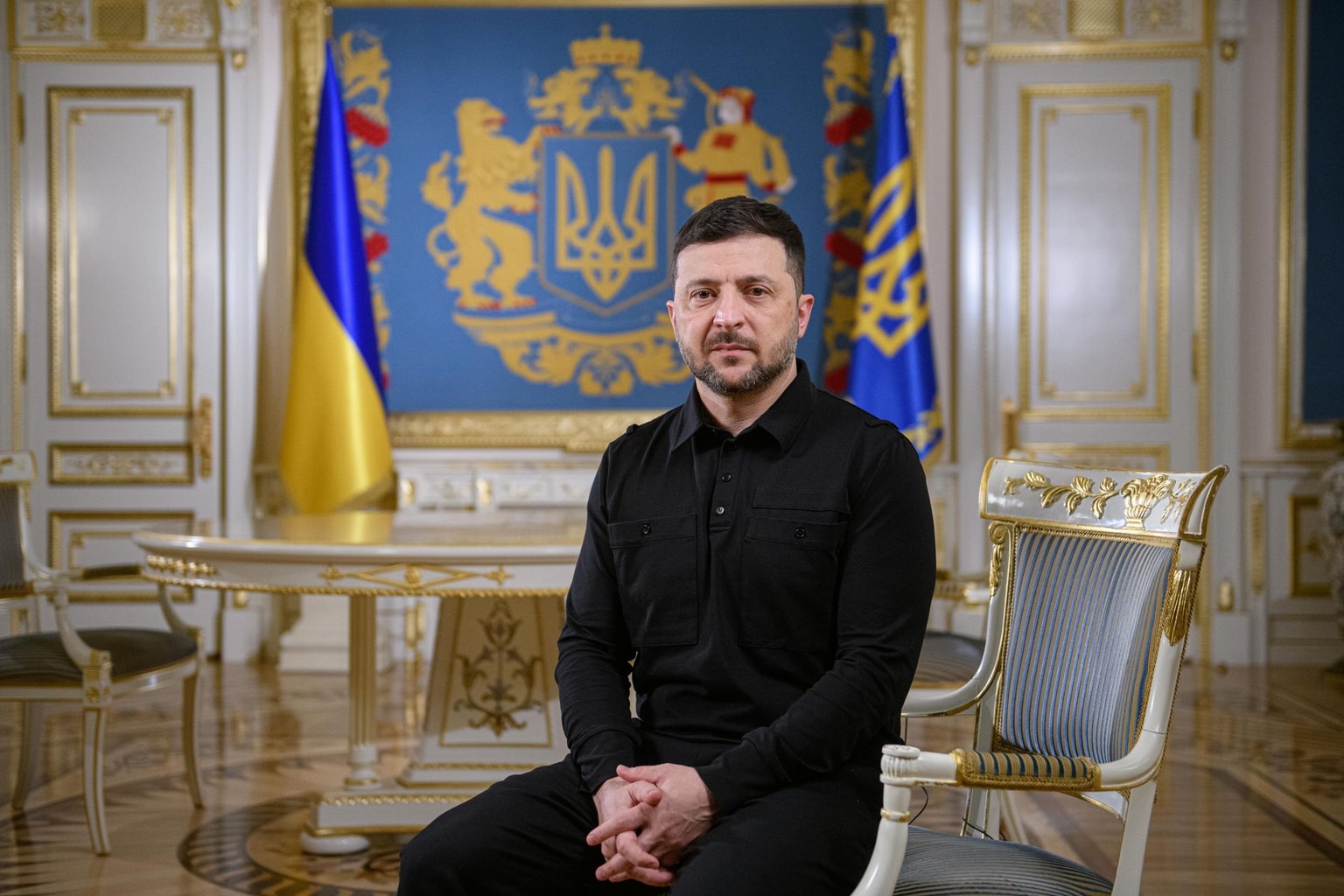How protests in Iran may affect war in Ukraine

Iran has played a key role in Russia’s recent attempts to terrorize Ukraine. As Russian front-line advances are failing, the Kremlin has been launching massive attacks on critical civilian infrastructure across Ukraine using Iranian-made drones.
“The whole world will know that the Iranian regime is helping Russia to continue this war,” Ukraine’s President Volodymyr Zelensky said in a national address on Nov. 6. “If it was not for the Iranian supply of weapons to the aggressor, we would now be closer to peace.”
Ukraine says that Tehran has already supplied hundreds of its drones to Moscow. And now, according to multiple reports, it is preparing to also deliver ballistic missiles to replenish Russia’s scarce stocks.
The weapon supplies are happening as Iran is facing a domestic upheaval.
With hijabs burning and authorities beating up school girls to death, Iran’s youth has taken to the streets, demanding the overthrow of the authoritarian and corrupt Iranian government after its killing of a young woman, Mahsa Amini.
Though the nationwide protests Tehran is facing have been called unprecedented, experts are skeptical they will affect the Iran-Russian relations and the course of the war in Ukraine in the near future.
‘Women, Life, Freedom’
Mass protests in Iran erupted after the murder of a 22-year-old Kurdish woman Mahsa Amini, who died after being arrested by Iran’s notorious morality police for allegedly not wearing her hijab “properly.”
The woman’s birth name was Jina, which stems from the Kurdish word for “life,” but her family had to register her as Mahsa due to Iran’s laws forbidding foreign and un-Islamic names. Upon arrest on Sept. 13, police took her to a “re-education” center where they said they would lecture her on the hijab law. After several hours in custody, Amini had to be taken to a hospital, where she died soon.
Iranian morality police, officially known as the Guidance Patrol, is tasked with monitoring the citizens’ adherence to Islamic rules, mainly the dress code, as outlined by the government. They primarily target women, and often brutally – over the years, stories of beatings and violent arrests became common.

This is why when Iran’s authorities blamed Amini’s death on pre-existing health conditions, few believed them. The woman’s family said she was tortured, and severely beaten on her body and head, which caused her death.
The incident sparked mass female-led protests around Iran, which some call unprecedented in both scale and unity. Women were seen taking off and burning their veils in front of police, chanting a Kurdish slogan “Women, Life, Freedom,” as thousands of people, mostly the youth, took to the streets.
As of Nov. 16, at least 342 people, including 43 children, have died as a result of the regime’s brutal crackdown on demonstrations, according to Iran Human Rights, an Oslo-based non-profit.
The government has been using “a lot of tear gas, paintball guns, and shotguns,” against the protesters, according to Atena Daemi, an Iranian activist on the ground who managed to get in touch with the Kyiv Independent despite the regime’s disruption of the internet. In some places the authorities used live ammunition, reportedly killing over 60 people in a single day on Sept. 30.
Iran’s role in Russia’s war
With domestic instability as a backdrop, the Iranian government emerged as an important ally for the Kremlin when it began supplying Russia with Iranian-made Shaded-136, Shaded-131 and Mohajer-6 drones for its war against Ukraine.
The Shaded drones are a loitering munition weapon, which means they can float passively in the air after takeoff, locate a target, and then strike. They are also relatively cheap, costing $20,000-30,000 as opposed to Russia’s Kalibr cruise missiles – widely used in Ukraine, each missile costs at least $1 million. The Shahed drones can also avoid radar detection, making them harder to intercept. Mohajer-6 are unmanned aerial vehicles, or UAVs, which can be used for both surveillance and attacks.
Russia has already used about 400 of these drones in Ukraine, with the Ukrainian military intercepting roughly 60-70% of them, Zelensky said on Oct. 26.
Dozens of Shaded-136 drones were used in a large Russian attack on Kyiv on Oct. 17, killing five civilians, including a pregnant young woman.
Though Ukraine and the West say Iranian involvement is clear, Tehran had been denying delivering weapons to Russia until finally admitting it on Nov. 5. The Iranian government said it had supplied “small numbers” of drones to Russia before Feb. 24, when Russia launched its full-scale invasion of Ukraine.
Zelensky accused Tehran of lying. “We shoot down at least 10 Iranian drones every day, and the Iranian regime claims that it allegedly gave (Russia) only a few and before the start of the full-scale invasion,” he said in an address on Nov. 5.
“If Iran continues to lie about the obvious, it means that the world will make even more efforts to investigate the terrorist cooperation between the Russian and Iranian regimes,” Zelensky said.
The U.S. also said Iran has sent a small number of its personnel to Russian-occupied Crimea to support the drone attacks. Western media has also recently reported that Iran agreed to supply Russia with medium-range missiles, an allegation Tehran has denied.
Apart from the weapons supply, Iran’s position on Russian aggression has been ambiguous. While Iranian Foreign Ministry has called for respect of territorial integrity of all countries and adherence to the UN charter, it has also shifted the blame for the war on the West and alleged NATO expansion.
“Had (Russia) not taken the initiative, the other side would have taken the initiative and caused the war,” Iran’s Supreme Leader Ayatollah Ali Khamenei said after a meeting with Russian dictator Vladimir Putin on July 19.
Circumstantial friendship
With the protests in Iran passing their tenth week, experts say they are unlikely to affect Iran’s weapon supplies to Russia and the war in Ukraine any time soon.
“Iran-Russia relations are situational, the protests themselves cannot affect them. What can affect (the relationship with) Russia and Ukraine are internal political changes,” Iliya Kusa, an analyst at the Ukrainian Institute for the Future told the Kyiv Independent.
“The arms deal between Iran and Russia was lobbied by that part of the Iranian government which has always supported such circumstantial relations with Russia to oppose America,” Kusa said.
As Russia beat Iran to the title of the most sanctioned state in the world, the relationship between the two countries grew closer.
Their bilateral trade increased after the start of the full-scale war, as Iran and Russia signed a memorandum to establish trade centers in Tehran and St. Petersburg to facilitate business. The National Iranian Oil Company also signed a cooperation deal with Russia’s energy giant Gazprom.
“This isn’t an eternal union or deep friendship. And this isn’t a fundamental long-term problem of the Iranian regime either, but rather an outcome of the current internal political configuration – at the moment, the power is in the hands of the more conservative politicians,” Kusa said, adding that they empower those who favor Russia.
According to the Institute for the Study of War, Iran’s recent admission of drone supplies to Russia – as well as Iran’s alleged requests for Russian assistance with its nuclear program – may indicate that Iran hopes to establish a security relationship with Russia in which they are “more equal partners.”
Kusa thinks the protests in their current form are not enough to bring about a revolution as they lack the necessary components – leaders who will take responsibility for change, and enough international support.
Yet they remain significant, he says.
“Even if these protests die out, the crisis itself isn’t over. There will be more protests, because the fundamental problems of Iran have little to do with hijabs or Mahsa Amini, they’ve been accumulating over the years,” Kusa said.
Kitaneh Fitzpatrick, an Iran expert at the American Enterprise Institute’s Critical Threats Project which tracks the protests daily, says the government is entrenching anti-regime sentiments deeper and deeper when using violence.
“Every time (the Iranian government) kills someone, they actually end up inciting more unrest. Iranian Gen Z, this young crowd who are the heart and soul of this movement, are not likely to forget the violence towards them and their peers. This is going to be a long-term problem,” Fitzpatrick told the Kyiv Independent.
Ihor Semyvolos, the director of Ukraine’s Association Middle East Studies, or AMES, also thinks Iran will face long-term instability.
“An internal political crisis is looming in Iran, and it might be the strongest the country has seen in a while. This means they will have to focus resources internally, which might weaken their external positions,” including relations with Russia, Semyvolos said.
“But they can also choose the path of expansion and escalation, so this is a dangerous moment. I think they themselves haven’t yet decided how to respond to these protests… and we are the witnesses of this uncertainty.”
Ukraine-Iran tensions
Ukraine’s relations with Iran have been strained even before the full-scale invasion.
In January 2020, Iranian missiles shot down a Kyiv-bound Ukraine International Airlines Boeing 737 with 176 people on board, just minutes after take-off from an airport in Tehran. Everyone on board, including 11 Ukrainians, were killed.
Iran said they mistook the Ukrainian plane for an American cruise missile, as the country was on alert in the wake of the U.S. killing of Iranian general Qasem Soleimani. Ukraine’s National Security and Defense Council secretary Oleksiy Danilov called the attack a premeditated terrorist act.
Ukraine maintained diplomatic relations with Iran after the catastrophe and technically still has them. After it became clear that Iran supplied weapons to Russia, Ukraine’s Foreign Minister Dmytro Kuleba initiated the process of severing ties with the country.
“Tehran bears full responsibility for the destruction of relations with Ukraine,” Kuleba said during a briefing on Oct. 18. He also called for sanctions against Iran.
The process of severing ties is still ongoing, and requires a decision by Zelensky. He is likely to make it “within weeks,” a member of Ukraine’s diplomatic corps said on Nov. 8. He added that Iran has been trying to stop the severance of ties.
Semyvolos thinks Ukraine has two options – cut ties with Iran completely, or minimize them, and try to continue negotiating.
“But I think negotiating with Iran is useless,” Semyvolos said. “Considering their circumstances right now… they clearly don’t plan to change their position (on the war).”













